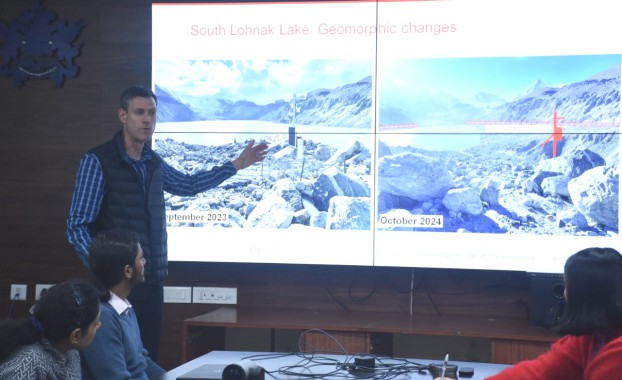




















Saturday, Nov 09, 2024 22:45 [IST]
Last Update: Friday, Nov 08, 2024 17:06 [IST]
GANGTOK, (IPR):
Sikkim State Disaster Management Authority (SSDMA), in collaboration with the
National Disaster Management Authority and the Swiss Agency for Development and
Cooperation, held a press conference following their successful expedition to
South Lhonak and Shako Chu Lake from October 19 to November 5, here at the
SSDMA State Control Room today.
The
conference was chaired by Namrata Thapa, secretary-cum-relief commissioner, Land
Revenue and Disaster Management department, along with Dr. Sandeep Tambe, secretary,
Department of Science and Technology; D.G. Shrestha, principal director, DST; Prabhakar
Rai, special secretary, Land Revenue and Disaster Management department; Mozart
Maxon from Swiss Development Cooperation who was the team leader of the
expedition, along with representatives from the Swiss Development Cooperation.
The
meeting emphasised the collective efforts of various State government
departments including Mines & Geology, National Disaster Management
Authority (NDMA), District Disaster Management Authority (DDMA) Mangan, and the
local authorities, Pipons and Indo-Tibetan Border Police, to study and mitigate
Glacier Lake Outburst Floods (GLOFs).
Namrata
Thapa mentioned that this expedition is a pioneering initiative for both the State
and the country, as they examined nine out of 16
vulnerable lakes identified across Lachen, Lachung, and West Sikkim. The
Sikkim Himtal Mission, Surakshit Sikkim, and Samrath Sikkim promote
self-reliance and empower local communities through an interdisciplinary team
approach, reducing dependency on external agencies, she said.
The
Swiss Development Cooperation, along with NDMA, local authorities, and SSDMA,
has been training locals in equipment use and maintenance of installed
monitoring stations. Following the flash floods of South Lhonak and Shako Chu
Lake, mitigation measures are being developed, with standard operating
procedures being prepared for future reference.
Dr.
Tambe provided insights into the study of Sikkim's 320 glacial lakes,
highlighting that while 16 require advanced testing, the remaining 304 are
considered normal. Strategies to manage risks from water levels and natural
hazards have been discussed, including the stability of dams and the creation
of water channels. The four-step testing process implemented by the State
government includes basic analysis, comprehensive tests, mitigation treatments which
may involve pumping and siphoning and the construction of check dams.
Pierre-Yves
Pitteloud expressed the Swiss Development Cooperation's long-standing
commitment to Sikkim and their admiration for the State authorities' proactive
measures in disaster management.
Additionally,
Christoph Haemming mentioned that the glacier lake outburst flood had
previously swept away the monitoring station at South Lhonak, prompting the
construction of a new monitoring station with advanced pressure probes at Shako
Chu Lake.
The
press conference concluded with the handover of the keys to the monitoring
stations at South Lhonak Lake and Shako Chu Lake to Namrata Thapa, signifying a
step forward in the ongoing efforts to ensure long-term sustainability and
safety in the region.
